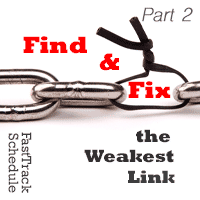 I am usually very energized by a new project. After all, there is a customer out there who is waiting to get started, eager to meet with me, and may have already left a couple of voice mails for me before I ever get the project officially handed off to me. I had one – US Airlines to be exact – who wanted a finish date for a software implementation I was going to be doing for them before we even met by phone so that they could put it in some airline industry publication. Talk about enthused. Or at least being pushed by someone higher up to look and act enthused.
I am usually very energized by a new project. After all, there is a customer out there who is waiting to get started, eager to meet with me, and may have already left a couple of voice mails for me before I ever get the project officially handed off to me. I had one – US Airlines to be exact – who wanted a finish date for a software implementation I was going to be doing for them before we even met by phone so that they could put it in some airline industry publication. Talk about enthused. Or at least being pushed by someone higher up to look and act enthused.
When you are used to that type of anticipation from the customer – or something close to that – it’s no wonder we can become frustrated when the indecisiveness – or lack of availability from a project sponsor gets in the way of forward momentum on an engagement…or even just getting it kicked off. When that indecision is coming from your direct customer, it cannot only be frustrating, but also very detrimental to the project. Every project manager knows all too well that delays caused by waiting on key decisions and input can cost time and money – two things that few projects have extra of.
So, what can the project manager and team do early and during the project on an ongoing basis to keep enthusiasm high and keep the project charging full steam ahead…thus avoiding those costly and annoying delays when your customer-side decision maker disappears for a week or two at a critical time in the project? For me, I focus on three things to keep the customer on track and making decisions and providing information in a timely manner. Let’s consider…
Communicate consistently
I always say that a good (and brief is ok) formal communication plan is a good thing to produce up front on a project. It’s important to establish some communication guidelines at the beginning of the project – preferably in the form of a formal communication plan document that requires acceptance and signoff. Projects that lack consistent, organized, and effective communication often suffer the consequences in customer satisfaction and the inability to get decisions made and action taken. If you find that your project is lagging in the communication area, that may be what is causing your customer to be slow to make key decisions. When confidence is lacking, decision-making is hard – that’s a simple fact. Regroup and see to it that you begin practicing effective, timely communication and see if things turn around.
Make the customer part of the team
The last thing you want is for the customer to feel like they are an outsider. If the customer is feeling more like an outsider than part of the project team, then they may be slow to make decisions and provide information. It could be a confidence thing, or it might have more to do with the need to exert some sort of control. In either case, drawing them into the team by assigning tasks to them, requiring input to key deliverables, and involving them more in critical decision-making efforts can help keep their satisfaction levels higher and their participation levels at a premium.
Meet regularly…always
This is a big one…meet when you say you are going to meet…always. Nothing says, “I don’t care” to a customer than constantly canceling scheduled meetings. They will come to expect inaction and disorganization from you and that’s no way to build trust. And when trust is lacking, decision-making is hard to come by. Be consistent – call meetings and hold them. Create agendas and send them out in advance. Deliver revised project schedules and status report every week. Promote good attendance. Provide post meeting status updates. Make sure everyone knows the meetings and their participation in them is critical.
Summary
There is no question that our project customers play very important roles on our projects – and I don’t mean just to pay our invoices. Their input is critical. Their decision-making is critical. And their accountability for the information you share is also important. Practice best practices on your project and you can start to do that by sticking to these items mentioned above. All three of these concepts presented here should help you and your client maintain a consistent, working relationship throughout the project engagement.



